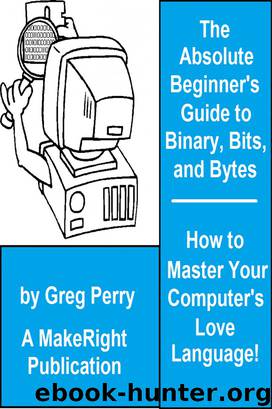The Absolute Beginner's Guide to Binary, Hex, Bits, and Bytes! How to Master Your Computer's Love Language by Greg Perry

Author:Greg Perry
Language: eng
Format: epub
Tags: computers, coding, computer programming, java programming, c programming language, greg perry, java language, java programming language, programming computers, writing programs
Publisher: MakeRight Publishing
Binary Numbers
Since a computer works best with l’s and 0’s, via its internal switches, its counting ability is limited to a base-2 (binary) numbering system. People work in a base-10 numbering system in the real world. The base-10 numbering system is sometimes called the decimal numbering system.
The rule is this: As many different digits are in a number system as the base of that number system. To put it in plainer terms, the base-10 system has 10 digits: 0 through 9. As soon as you count to 9 and run out of digits, you have to combine some that you already used. The number 10 is a representation of ten values, but combines the digits 1 and 0. So in base-10, the system people use, there are ten digits 0-9. When you need an 11th digit to represent the number we call “ten,” we have to combine two digits because there is not an 11th unique digit.
So we count like this: 0, 1, 2, 3, 4, 5, 6, 7, 8, 9, 10, 11, 12,…
After the number we call “nine,” we must from that point forward combine digits from the first 10.
So people use base-10. Computers use base-2 because a switch can be either on or off.
In a base-2 numbering system only two unique digits are possible: 0 and 1.
As soon as you run out of digits, after the number we call “one,” you have to reuse digits. The first seven binary numbers therefore are:
0 1 10 11 100 101 110 …
If you do not understand how these numbers were derived, that is okay; you will see how in a moment. For the time being, you should realize that no more than two digits, 0 and l , can be used to represent any base-2 number, just as no more than ten digits , 0 through 9 can be used to represent any base-10 number in our human decimal ''real-world'' numbering system.
To the Power of Zero
Any number, 2, 10, 5, 232 or whatever, when raised to the zero power, always equals 1. So, 20 equals 1, 30 equals 1, 60 equals 1, 100 equals 1, and even 4928570390 equals 1.
What Numbers Mean
You should know that a number such as 2,981, does not really mean anything by
itself. You must always know what the base is for a number. You get very used to working with base-10 numbers since that is what people use and you’ve used it all your life. However, the number 2 ,981 actually represents a quantity based on the powers of 10. For example, Figure 5 shows what the number 2,981 actually represents. Notice that each digit in 2,981 stands for a certain number of a power of 10.
Download
This site does not store any files on its server. We only index and link to content provided by other sites. Please contact the content providers to delete copyright contents if any and email us, we'll remove relevant links or contents immediately.
A Tour of C++ (C++ In-Depth Series) by Stroustrup Bjarne(1568)
Unreal Engine 4 Virtual Reality Projects by Kevin Mack(1505)
Hands-On C++ Game Animation Programming by Gabor Szauer(1330)
Learn WebAssembly by Mike Rourke(1214)
Learn OpenCV 4 by Building Projects by David Millán Escrivá(1161)
Unreal Engine 4 Shaders and Effects Cookbook by Brais Brenlla Ramos(1158)
Hands-On Microservices with Rust by Denis Kolodin(1133)
C++ Concurrency in Action: Practical Multithreading by Anthony Williams(881)
C++ Data Structures and Algorithm Design Principles by John Carey Shreyans Doshi & Payas Rajan(814)
Advanced C++ by Gazihan Alankus Olena Lizina Rakesh Mane Vivek Nagarajan and Brian Price(807)
Beyond the C++ Standard Library: An Introduction to Boost by Björn Karlsson(783)
The C++ Standard Library: A Tutorial and Reference (2nd Edition) by Josuttis Nicolai M(724)
C++ All-In-One Desk Reference For Dummies by John Paul Mueller(679)
Make an Arduino-Controlled Robot by Michael Margolis(656)
C++ Crash Course by Josh Lospinoso(583)
Learning DCOM by Thai Thuan(553)
Data Structures and Algorithm Analysis in C (1st Edition) by Mark Allen Weiss(538)
UML 2.0 in a Nutshell by Dan Pilone & Neil Pitman(527)
Atmospheric Monitoring with Arduino by Patrick Di Justo & Emily Gertz(519)
